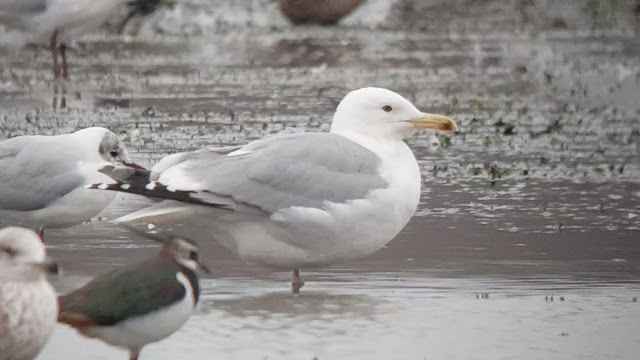It's the end of March but it seems more like mid April: everything is a good couple of weeks early at the moment. In fact we have a fair bit of early spring migrant action to report already. Testamony to this is the fact that we've had the first singing Willow Warbler working its way north already - normally it's towards the end of the second week of April when we might start to expect this species.
Another key development has been how wet March is. In stark contrast to the drought that was Feburary, this month has been extremely wet which has meant that the floods are very full. This bodes very well for the crucial spring passage period but at the moment there is no smooth shoreline for the smaller waders to feed along so it's got a different feel to it. Also birds are a long way away as far as viewing is concerned.
Let's start by giving a round-up of the waders that have graced the floods. We've had up to four Little Ringed Plover before the floods got too large. There were also a couple of Redshank, up to 4 Oystercatchers and one or two Dunlin. The main wader happening was right towards the end of the month when a flock of 29 Black-tailed Godwits turned up along with a single Greenshank. Again March is very early for the latter species which I tend more to associate with mid to late April.
 |
| The Black-tailed Godwit flock courtesy of Matthew Lloyd |
 |
| Two Little Ringed Plover |
On the Gulls and Terns front the highlight was a fly-through Sandwich Tern. This is a realy patch rarity though in recent years there have been a smattering of records so I think this is the fourth one for the Meadow since my time birding it. There has also been an adult Mediterranean Gull in the roost regularly, joined by a 2nd winter bird one evening.
The adult Mediterranean Gull
We've had a few small flocks of Sand Martins starting to come through though none have lingered so far. We also had our first Swallow pass through as well. Another sign of spring is the arrival of the first White Wagtails with a couple having been seen already. Again this is normally an April species so it too is early. The Siberian Chiffchaff has been seen on and off until the end of the month in its usual place along the allotment hedgerow.
There's not been much to report amongst the waterfowl, with some dodgy White-fronted Geese having been seen again. There have been up to 4 Egyptian Geese about - they may well breed in the area again like last year. Sadly there have been no Garganey so far.
Finally a really left-field record of a Merlin (a patch Mega) being chased by a couple of Peregrines along Leckford Rd!
Looking ahead, we are now heading into what is arguable the most exciting month of the year on the Meadow with a lot of passage birds to look out for whilst we still have the flood waters. This month and the first couple of weeks of May are when we would look to bank the majority of our year list ticks including those crucial wader records. It's an exciting time of year!










